This Westminster constituency gave Órfhlaith Begley (Sinn Féin) a majority of 7,478 votes over Thomas Buchanan (DUP). The constituency was created in 1997 and has been in nationalist hands since 2001. Begley was originally elected in a by-election in 2018.

The changes made to the constituency boundaries last November were not substantial.
Candidates
Órfhlaith Begley, Sinn Féin
Matthew Bell, UUP
Tom Buchanan, DUP
Stephen Donnelly, Alliance
Leza Marie Houston, Aontú
Stephen Lynch, Conservative
Daniel McCrossan, SDLP
Stevan Patterson, TUV
Candidates’ Electoral History
Begley Westminster MP 2018 to date
Bell Council co-opted for Omagh 2018 – 19. Re-elected 2019 to date
Buchanan Assembly MLA 2003 to date
Council elected for West Tyrone 1993 to 2014
Westminster stood 2005, 2010, 2015, 2017, 2018 (by), 2019
Donnelly Council elected for Omagh 2019 to date. Stood 2014
Assembly stood 2016, 2017, 2022
Westminster stood 2015, 2017, 2018(by), 2019
Houston Council stood for Derg 2023
Lynch Council stood Chesterfield Borough 2023
McCrossan Assembly co-opted 2016. Re-elected 2016 to date
Westminster stood 2015, 2017, 2018(by), 2019
Patterson retired computer technician


Vote shares by designation
There were no changes to the boundaries between 2010 and 2023.
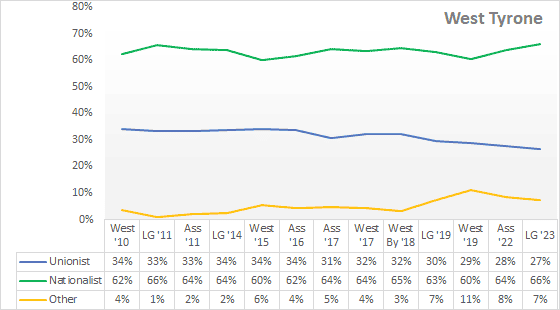

Please note that some Local Government electoral areas cross constituency boundaries which means that the LG figures have been estimated.
The nationalist trend across the period has been up 1%. Unionists are down 7%, having dropped below 30% for the last three elections. Others are up 6%.
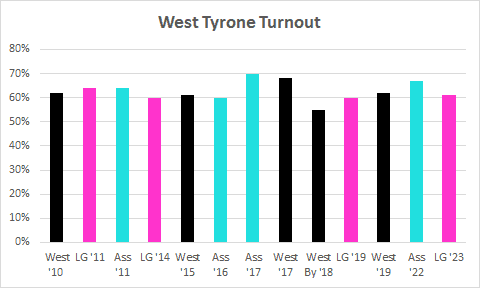

Vote share by party in Assembly and Local Government Elections
In the majority of constituencies there is an element of tactical voting in Westminster elections. Changes in the underlying strength of the principal parties within a constituency can best be understood by looking at their performance in other elections.
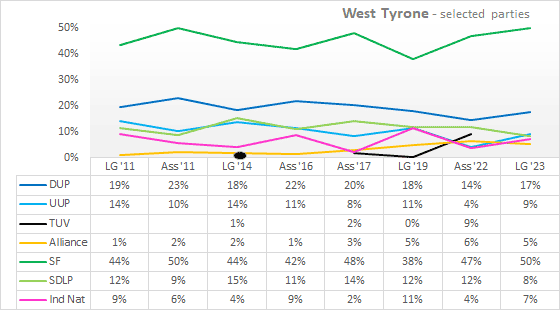

The bottom half of the chart is crowded, so I reproduce it below at greater scale.
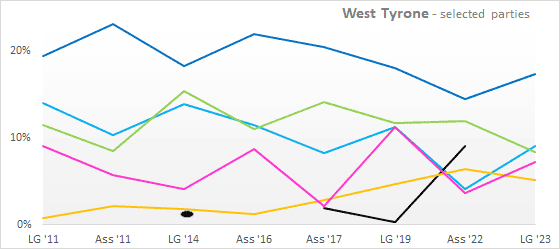

Apart from Aontú, which obtained 2% in the 2019 Council elections, no other party has scored more than 1% in any election in the period.
Both the Sinn Féin and SDLP votes oscillate substantially around a trendline which is almost flat, up 1% point over the period in the case of SF, and down 1% for the SDLP. The cause is the continuous presence of Independent nationalists which can attract many votes, particularly in Council elections – up to 11% in 2019.
The UUP has experienced the biggest drop, down 7%, falling below Alliance in the last Assembly election. The DUP has suffered almost as greatly, its trendline sloping down 5% points, particularly badly hit by the TUV in the last Assembly election. It can console itself that the picture could have looked worse if the TUV had stood candidates at the 2023 Council elections.
Alliance shows the biggest upward trend, 5%, potentially putting it close to competitiveness in a future Assembly election.
Vote share in Westminster elections
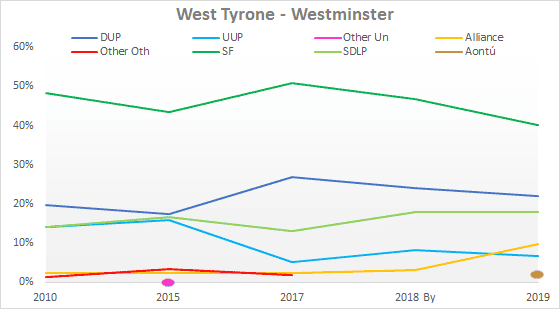

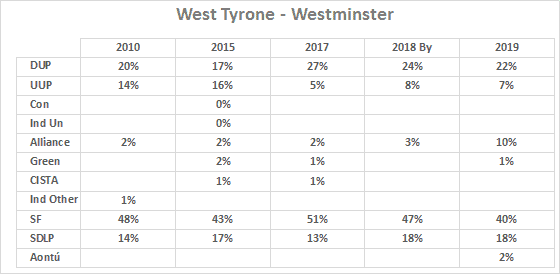

CISTA fought the elections on a platform of legalising cannabis.
Unusually there is no convincing evidence for tactical voting in West Tyrone during this period.
The Sinn Féin Westminster vote never strays more than 2% from the level other elections would suggest. The SDLP always has 4 to 6% above their level in other elections, but that can be explained by the absence of Independent nationalists from Westminster elections.
The DUP always comes in 3 or 4% points above their share average in other elections, but there is no competition from the TUV. Only in 2010 did the UUP come in below its expected level, suggesting one possible occasion of tactical voting.
If this pattern held true for the coming election, then the 2024 vote would be:
SF 46% – 51%
DUP 19% – 20%
SDLP 14% – 16%
UUP 2% – 11% (wider range since no consistent pattern)
Alliance no pattern established
However, that does not account for boundary changes or the presence of the TUV splitting the DUP vote.
The boundary changes
Calculating the effects of changes to constituency boundaries is not straightforward since there is no record of precisely how past votes for each party were distributed geographically. Necessarily this involves estimates and assumptions, and these may differ. For many years the UK media have all used the calculations provided by two academics, Rallings and Thrasher, to provide a notional result of how each constituency would have voted at the previous general election if the latest boundaries had been in force. For Northern Ireland their inputs are provided by Nicholas Whyte. These will be the base from which the media will report voting swings when constituency results are declared.
I used different assumptions for my own calculations of the notional vote which resulted in slightly different outcomes. In the following chart the Actual result in 2019 is compared with my estimate and the R&T estimate.
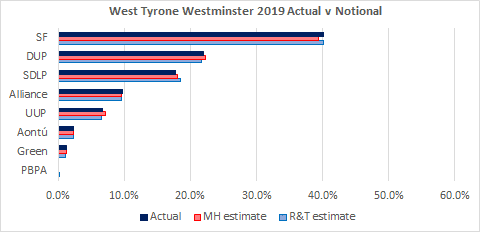

Although this gives slightly different notional majorities for 2019, it is obvious that the boundary changes are likely to make little difference to party shares.
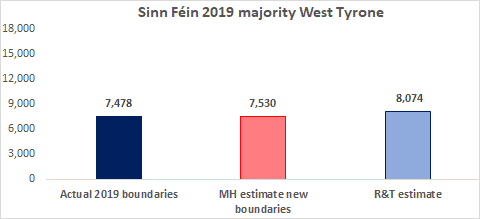

Resources
In addition to money, the other key resource for an election campaign is the level of constituency work running up to the campaign, and the manpower available in the campaign itself. When it comes to constituency work MP’s and MLA’s have the advantage of an allowance for constituency offices and for a staffing. The amount of staffing money is specified, but MP’s and MLA’s can choose to allocate it to fewer higher-paid staff or a greater number of lower-paid staff.
When it comes to manpower for canvassing and leafleting a party’s elected representatives normally form the core of the group available. Party’s may also choose to bring in helpers from neighbouring constituencies which they have no hope of winning.
The Index Total for each party gives some idea of the relative strength of each party locally.
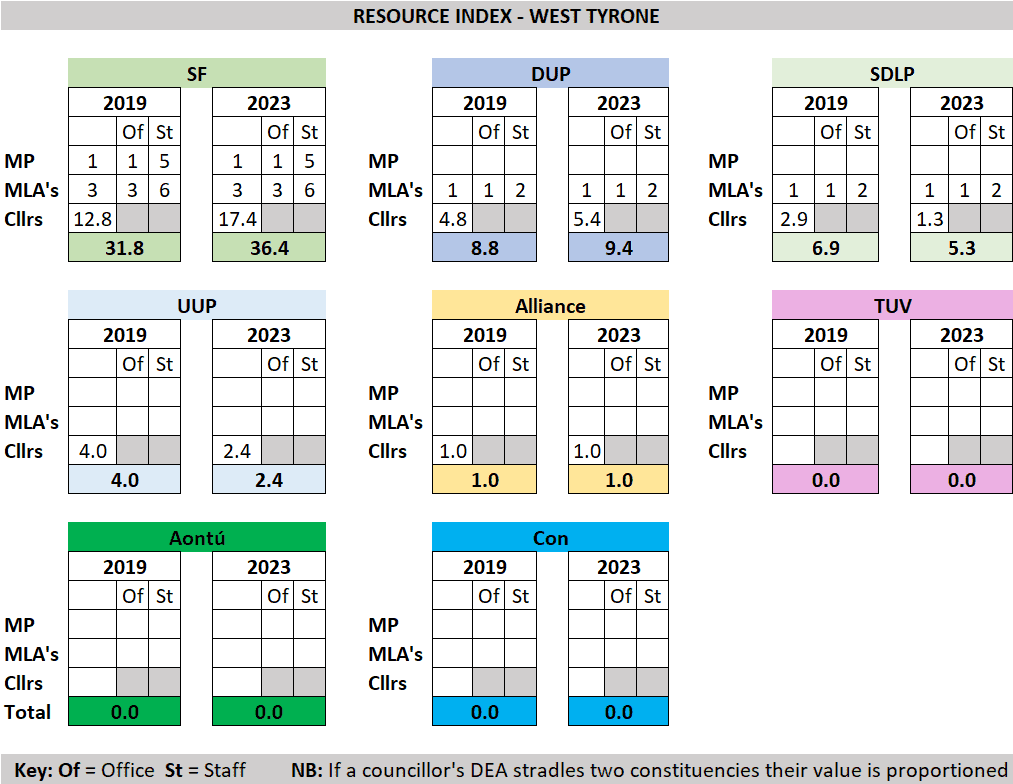

No-one can compete with the Sinn Féin machine in this constituency, and it is looking even stronger since the last election with the addition of five councillors.
When it comes the tussle for second place, the DUP had a resource advantage compared to the SDLP in 2019 which has grown since. The DUP have gained an extra Councillor, whereas the SDLP has lost two.
The TUV might have won one or two Council seats if they had had even a minimal local organisation in 2023.
With the first place not in doubt, let’s look at the prospects for second place. Last time the DUP was second and the SDLP third.
Factors possibly assisting the DUP
Lack of TUV organisation. The fact that the TUV failed to stand council candidates in a constituency where they gained 9% of the vote in the year before indicates that they had no local organisation to speak of. That may not have changed.
Could the TUV intervention assist the DUP to squeeze 1 or 2% points from the UUP vote?
More Councillors available to campaign than the SDLP.
Factors possibly harming the DUP
The TUV candidate could subtract up to 9% points share from DUP, at the TUV’s 2022 Assembly vote share. (Watch the LucidTalk polls. If the TUV share falls below 7%, the TUV can be expected to hurt the DUP proportionately less. If the TUV goes higher than 7% the damage may be proportionately more.)
Total unionist vote decline. Between the 2019 and 2023 Council elections there was a 3% points drop. Depending on the TUV share, this could subtract a further 1 or 2% points from the previous DUP share.
Factors possibly harming the SDLP
SDLP vote decline. Between 2019 and 2023 Council elections there was a 3% points drop.
Conclusion
Sinn Féin will win.
There is too much overlap between the best-case and worst-case DUP and SDLP scenarios for a call on who will come second. Either way, the balance of probabilities strongly suggests that the Sinn Féin majority will increase by at least two thousand.
Michael Hehir is a retired sales and marketing manager. He studied in Northern Ireland but now lives between England and Italy.
Discover more from Slugger O’Toole
Subscribe to get the latest posts to your email.



